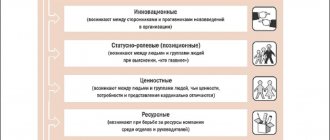All existing sciences have a simple model, for example, in physics - an atom, elementary particles, in chemistry - a chemical element. In sociology, such a model is a category, which is a model of the simplest social phenomenon that historically precedes the formation of society, each social system. One person cannot be considered an “atom” to create a social structure, since society is created by people. They must meet, exchange goods with each other, communicate using various available means for this: telephones, tom-toms. Only in this case is a social system formed, which exists only if there are at least two people connected by different social interactions. This case will be called the simplest social phenomenon. And it may well be the simplest form of society if two people are of different sexes. An example is the biblical story of Adam and Eve, since to create society it was necessary to have two people of different sexes.
Social interaction is defined as the result of the influence of people on each other, where every action is shaped by a previous action and the expected result on the part of the other.
There must be at least two people involved in the interaction. The participants in the interaction are called interactants . Social interaction was considered as the simplest social phenomenon in the works of J.G. Mida. Theories of social interaction were developed by such famous Western sociologists as T. Parsons and J. Homans. Social life, social processes, according to P.A. Sorokin, appear to be combinations of different social interactions.
Four signs of social interaction:
- Objectivity. There is an external goal, a reason in relation to interacting individuals or groups of individuals.
- External expression. Observable because interaction occurs through the exchange of signs and symbols that must be deciphered by the other party.
- Situational. It is characterized by a connection to an event, conditions of occurrence, for example, getting a job.
- Subjectivity of participants' intentions.
In social interaction there is feedback, which presupposes the existence of a reaction that is allowed and expected.
Types of interaction
In psychology, such a concept as interaction is revealed as the actions of people directed towards each other. Such actions can be considered as a set of certain actions aimed at achieving one’s goals, solving practical problems and realizing value guidelines.
Basic types of human interaction
Various types of interaction are distinguished depending on the situation that caused it. This is what gave rise to their various classifications.
The most common classification is based on performance orientation.
Types of interaction in the communication process
- Cooperation is an interaction in which its participants reach a mutual agreement on how to act to achieve common goals and try not to violate it as long as their areas of interest coincide.
- Competition is an interaction that is characterized by the achievement of one’s personal or social goals and interests in conditions of confrontation of interests between people.
Types of interpersonal interaction often determine the nature of relationships between people. The division into types can be based on the intentions and actions of people, which indicate how each participant in the interaction understands the meaning of what is happening. In this case, 3 more types are distinguished.
Types and types of interaction
- Additional. This is an interaction in which partners calmly and objectively treat each other’s positions.
- Intersecting. An interaction during which participants, on the one hand, demonstrate a reluctance to understand the position and opinion of other interaction partners. At the same time, on the other hand, they actively demonstrate their own intentions in this regard.
- Hidden interaction. This type includes two levels at once: external, expressed verbally, and hidden, manifested in a person’s thoughts. It assumes either very good knowledge of the participant in the interaction, or your sensitivity to non-verbal means of communication. These include tone of voice, intonation, facial expressions and gestures, in general, everything that can give a hidden meaning to a conversation.
Styles and types of interaction and their features
- Cooperation. It is aimed at the complete satisfaction of interaction partners with their needs and aspirations. Here one of the motives given above is realized: cooperation or competition.
- Opposition. This style involves focusing on one’s own goals, without taking into account any interests of the other party involved. The principle of individualism appears.
- Compromise. It is realized in partial achievement of the goals and interests of both parties.
- Compliance. It involves sacrificing one’s own interests to achieve the goals of a partner or giving up minor needs to achieve some more significant goal.
- Avoidance. This style represents withdrawal or avoidance of contact. In this case, it is possible to lose your own goals to exclude winnings.
Sometimes activity and communication are considered as two components of the social existence of society. In other cases, communication is designated as a certain aspect of activity: it is included in any activity and is part of it. The activity itself appears to us as a condition and basis for communication. Moreover, in psychology, the concepts of “interaction” “communication” are at the same level as “personality” “activity” and are fundamental.
Types of interaction in psychology play a huge role not only in interpersonal communication, but also in the process of human development and, as a consequence, society as a whole. Without communication, human society would not be able to fully function, and we would never have reached such heights of socio-economic development as we do now.
Structure and forms of social interaction
Sociologist P.A. Sorokin defines social interaction as the initial unit of sociological analysis.
The structure of social interaction is a connection of 3 elements:
- At least 2 individuals enter into an act of interaction with each other and thereby determine each other’s behavior.
- Acts, i.e. actions of individuals. An action is the result of the internal mental activity of an individual, and on the other hand, a stimulus that causes one or another reaction in other persons.
- Availability of conductors. There are material and symbolic actions of individuals. Conductors include language, writing, money, clothing, ceremonies, images, monuments, household items, railways, telegraph and telephone communications, etc. The role of material vehicles is based on their physical qualities, and the role of symbolic vehicles is based on the symbolic meaning ascribed to them.
Social interaction occurs in many areas of social life .
- Political. Confrontations or cooperation between participants in political parties and social movements.
- Professional. Participants come from a variety of professions.
- Economic. Participants act as owners and employees.
- Family-related.
- Demographic. Representatives of different genders, nationalities, and ages interact with each other.
- Territorial-settlement. Represents clashes, competition between locals and newcomers, etc.
- Religious. Those in contact are adherents of different religions, atheists, believers.
P. A. Sorokin believed that interaction is considered an exchange. In this regard, he identified three types of social interaction .
- Exchange of beliefs, opinions, thoughts, ideas.
- Exchange of volitional impulses. Involves coordination of actions between participants to achieve common goals.
- Exchange of feelings. Uniting or dividing people due to the emotional aspect of love, hatred, condemnation, etc.
There are 4 main types of social interaction based on the way in which contact between interacting people and groups occurs :
- physical;
- verbal, verbal;
- facial expressions, gestures (non-verbal);
- internal (inner speech).
These types have such properties as: motivation, focus on another person.
T7 Team Effectiveness Model
The T7 model was also described in the 90s of the last century. Its authors tried to understand and study what factors influence team effectiveness. In their opinion, there are 7 such factors - five internal and two external. They all start with the letter "T":
- Thrust
- focusing on the essence. It is a shared commitment to what should be accomplished by the team. - Trust
in each other within the team. - Talent
– abilities of team members. - Team Skills
– the ability to function effectively and efficiently as a team. - Task Skills
– successful completion of tasks assigned to the team.
External factors:
- Team Leader Fit
- The degree to which the leader meets the needs of team members. - Team Support
(team support from the company) is the measure in which the company’s management allows the team to express themselves.
Each of the factors listed above in this model can be detailed.
For a team to be highly productive, all five internal factors must be present.
Interaction and communication between people
The phenomenon of communication, in addition to psychologists and sociologists, is actively studied by philosophers, psychiatrists and scientists. However, a correct understanding of the communication process and ways to solve problems arising in connection with it are complicated by a large number of interpretations of this concept.
Articles on the topic
- How to recognize a liar and manipulator during communication 10/26/2021
- Current techniques for working with the subconscious 09.20.2021
- The most important areas of education 08/28/2021
- The primary goal of raising children in modern society 05/20/2021
Interaction (interaction) is just one of the elements of communication. It also includes:
- communicative actions involving the exchange of information;
- social perception associated with the understanding and perception of interlocutors.
Unlike interaction, in the process of communication they can be identified in their pure form, but only theoretically, when analyzing the success of communication.
The main factor influencing the normal development of human communications is the psychological compatibility of the subjects of interaction. Thanks to it, in a separate social group, if necessary, the interchangeability of one member with another easily occurs.
Lencioni model
The model proposed by Patrick Lencioni is also called the “5 Dysfunctions of a Team.”
The book of the same name was published in 2005. By studying this model, you will learn about work group effectiveness based on what causes dysfunction, misunderstanding, and conflict within the group.
According to the author, all teams have the potential to be dysfunctional. The model includes 5 main dysfunctions of any team: lack of trust, fear of conflict, lack of commitment, avoidance of responsibility, inattention to results.
- Lack of trust
occurs when team members show vulnerability and are unwilling to admit their mistakes and weaknesses. They don't ask for help. - Fear of conflicts
. Without trust, it is impossible to fully communicate. In such cases, internal conflicts can turn into veiled discussions and closed discussions. - Lack of Commitment
– Without constructive discussions about conflicts, it is difficult for everyone on the team to contribute to the solution. Ambiguity appears. - Avoidance of responsibility
. People don't want to hold others accountable for their work. - Inattention to results
. If team members don't take responsibility, they tend to put their personal needs ahead of team goals. If the team loses sight of the need to achieve results, the overall focus is lost.
Lencioni's model is visualized as a pyramid: you solve each dysfunction one by one from the bottom up.
Katzenbach and Smith model
The authors of this model, John Katzenbach and Douglas Smith, described their approach in 1993 after studying many teams in different companies and industries. They defined a team as a small group of people with diverse skills committed to common goals and a common strategy. The fundamentals of the model were compiled in the book The Wisdom of Teams. The authors distinguish between types of teams according to their development:
- Working group
, where the interaction of participants is carried out to exchange information and experience. - Pseudo-team
, in which its members can increase their work efficiency, but do not make any effort to do so. - A potential team
that understands a common goal and its necessity and tries to develop effective ways to collaborate. - A true team
consists of members who have complementary skills and abilities. They are aware of common goals and objectives and work together on them. - A high-performing team
with the characteristics of a true group and promoting the individual development of its members. Her results usually exceed expectations.
The authors visualized the model of effective teams using a triangle diagram. There are three benchmarks that teams measure themselves against:
- collective products and achievements
- work results
- individual growth
Teamwork should be subject to the following principles:
- selection of team members according to their skills, abilities and capabilities
- defining the goals of joint activities and rules of conduct
- team members' awareness of their rights
- continuous interaction within the team, allocating the necessary time for communication
- feedback, rewards and recognition.
Theories of Interpersonal Interactions
Sociologists, faced with problems of interpersonal interactions, create theories that address issues of human contact.
Homans and Blau's exchange theory uses the incentive principle. One person performs the actions (works), the other rewards the work. Contact will continue if both receive the expected result. In an asymmetrical exchange, when one dictates terms and the other strives to fulfill in order to receive a reward, power is born.
Mead and Bloomer, in the theory of symbolic interactionism, argue that the basis of interactions is conscious communication with meaningful own actions and intentional behavior of the partner. For the process to be effective, the ability to mentally take the place of the interlocutor is required. In this case, external and internal communications arise.
Parsons' systems approach explains two-way interaction, when the participants in the interaction, individually, are agents in relation to other partners. At the same time, they are also objects for other participants. The interaction of more people creates uncertainties in relationships, accompanied by economic difficulties, political and regulatory problems.
According to Goffman's impression management theory, it is assumed that:
- Unfocused interaction that occurs when there is a large crowd of people present and communicating through verbal communication. Appearance, gaze, facial expression, gestures are ways of conveying one’s own impression at this time.
- In focused interaction, partners notice the words and actions of the other participant. The background for such interactions is unfocused communication.
Social interactions: classification according to Sorokin
The classic of world sociology identifies the grounds for classification:
- number of interacting people;
- short-term or long-term interaction;
- unilateral or multilateral interaction;
- Whether the interaction is organized or not;
- spontaneously or deliberately;
- intellectual, sensory-emotional or volitional level of interactions.











